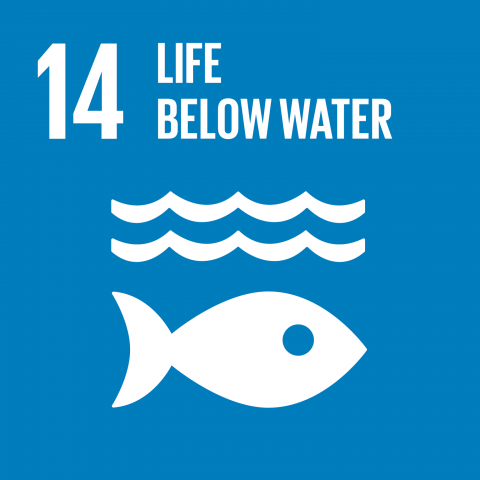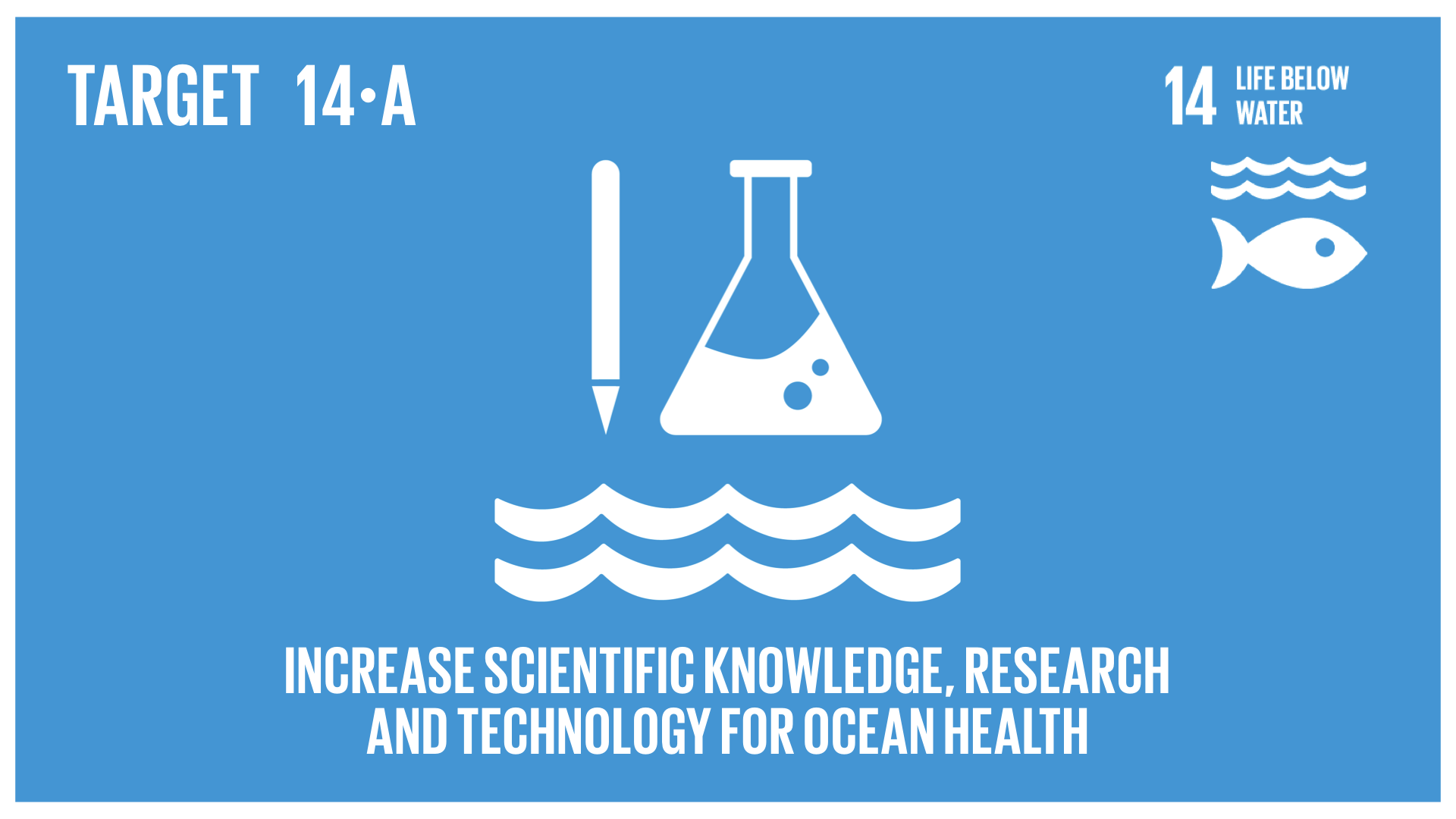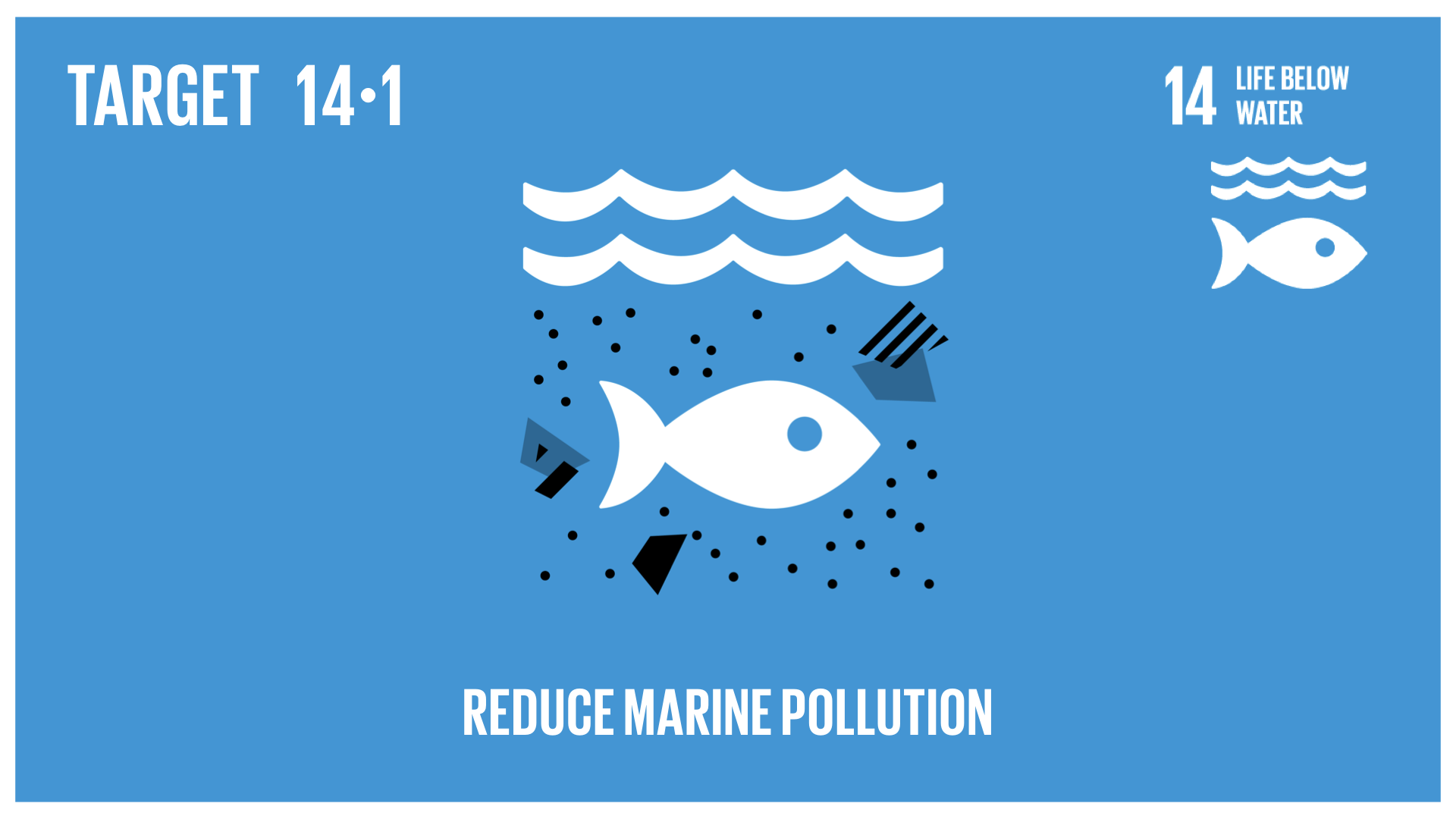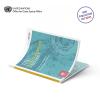SDG 14 - Life below water

Conserve and sustainably use the oceans, seas and marine resources
The world’s oceans – their temperature, chemistry, currents and life – drive global systems that make the Earth habitable for humankind. Our rainwater, drinking water, weather, climate, coastlines, much of our food, and even the oxygen in the air we breathe, are all ultimately provided and regulated by the sea. Throughout history, oceans and seas have been vital conduits for trade and transportation.
Careful management of this essential global resource is a key feature of a sustainable future. However, at the current time, there is a continuous deterioration of coastal waters owing to pollution and ocean acidification is having an adversarial effect on the functioning of ecosystems and biodiversity. This is also negatively impacting small scale fisheries.
Marine protected areas need to be effectively managed and well-resourced and regulations need to be put in place to reduce overfishing, marine pollution and ocean acidification.
Facts and Figures
- Oceans cover three quarters of the Earth’s surface, contain 97 per cent of the Earth’s water, and represent 99 per cent of the living space on the planet by volume.
- Over three billion people depend on marine and coastal biodiversity for their livelihoods.
- Globally, the market value of marine and coastal resources and industries is estimated at $3 trillion per year or about 5 per cent of global GDP.
- Oceans contain nearly 200,000 identified species, but actual numbers may lie in the millions.
- Oceans absorb about 30 per cent of carbon dioxide produced by humans, buffering the impacts of global warming.
- Oceans serve as the world’s largest source of protein, with more than 3 billion people depending on the oceans as their primary source of protein
- Marine fisheries directly or indirectly employ over 200 million people.
- Subsidies for fishing are contributing to the rapid depletion of many fish species and are preventing efforts to save and restore global fisheries and related jobs, causing ocean fisheries to generate US$50 billion less per year than they could.
- Open Ocean sites show current levels of acidity have increased by 26 per cent since the start of the Industrial Revolution.
- Coastal waters are deteriorating due to pollution and eutrophication. Without concerted efforts, coastal eutrophication is expected to increase in 20 percent of large marine ecosystems by 2050
Space-based Technologies for SDG 14
SDG 14 aims to sustainably manage and protect water ecosystems. Satellite technology can provide valuable data on water levels and pollution. Through COPUOS, States discuss national, regional and international water-related activities. UNOOSA helps countries access satellite data for better management and protection of water resources. UNOOSA also brings together experts to discuss cooperation, capacity-building and future approaches to water resource management.
Related Content
Article
Conservación de humedales: cómo la observación por satélite apoya la gestión sostenible de los humedales
Translated by: Isabel Zetina
El 2 de febrero de 2020 celebramos el Día Mundial de los Humedales para concienciar al mundo sobre el papel vital de los humedales para las personas y nuestro planeta. La edición de este año destaca la conexión entre el agua, los humedales y la vida.
Exploring the exciting potential of hyperspectral imaging for water quality monitoring
Harmful Algal Blooms occur when toxin-producing algae experience excessive growth within bodies of water. These blooms have the potential to cause detrimental effects on both aquatic and human health and can sometimes even cause death, depending on the type of algae involved (NIEHS, 2021). Thanks to the use of space-based remote sensing technology to monitor water quality conditions in coastal areas and drinking water reservoirs, nations are becoming more aware of the quality of their water.
Conservación de humedales: cómo la observación por satélite apoya la gestión sostenible de los humedales
Translated by: Isabel Zetina
El 2 de febrero de 2020 celebramos el Día Mundial de los Humedales para concienciar al mundo sobre el papel vital de los humedales para las personas y nuestro planeta. La edición de este año destaca la conexión entre el agua, los humedales y la vida.
Exploring the exciting potential of hyperspectral imaging for water quality monitoring
Harmful Algal Blooms occur when toxin-producing algae experience excessive growth within bodies of water. These blooms have the potential to cause detrimental effects on both aquatic and human health and can sometimes even cause death, depending on the type of algae involved (NIEHS, 2021). Thanks to the use of space-based remote sensing technology to monitor water quality conditions in coastal areas and drinking water reservoirs, nations are becoming more aware of the quality of their water.
基于卫星遥感的河流三角洲监测
Translated by Dr. Mengyi Jin
自古以来,河流三角洲因水资源丰富、土壤肥沃及交通便利而成为人类聚居的重要区域。这一格局延续至今。目前,生活在三角洲地区的人口已接近 60 亿,使其成为全球人口最稠密的地区之一(Kuenzer 和 Renaud,2011)。然而,这些三角洲地区正面临着气候变化、海平面上升、土地利用方式转变以及生态系统退化等威胁。遥感技术在获取环境状况及其时序变化方面具有显著优势,其在识别灾害前兆信号、预测自然现象演变等方面发挥着关键作用。在三角洲地区,遥感已被广泛应用于海岸线变化监测、洪水监测与预测等领域(Merkuryeva 等,2015;Li 和 Damen,2010)。持续开展三角洲监测不仅有助于维护其生态功能,还能及时识别潜在风险,并为科学管理提供重要依据,而遥感正是实现这一目标的关键技术。
Wetlands conservation: How satellite observation supports sustainable wetland management
On 2 February 2020, we celebrate World Wetlands Day to raise global awareness about the vital role of wetlands for people and our planet. This year’s edition highlights the connection between water, wetlands, and life.
基于卫星遥感的河流三角洲监测
Translated by Dr. Mengyi Jin
自古以来,河流三角洲因水资源丰富、土壤肥沃及交通便利而成为人类聚居的重要区域。这一格局延续至今。目前,生活在三角洲地区的人口已接近 60 亿,使其成为全球人口最稠密的地区之一(Kuenzer 和 Renaud,2011)。然而,这些三角洲地区正面临着气候变化、海平面上升、土地利用方式转变以及生态系统退化等威胁。遥感技术在获取环境状况及其时序变化方面具有显著优势,其在识别灾害前兆信号、预测自然现象演变等方面发挥着关键作用。在三角洲地区,遥感已被广泛应用于海岸线变化监测、洪水监测与预测等领域(Merkuryeva 等,2015;Li 和 Damen,2010)。持续开展三角洲监测不仅有助于维护其生态功能,还能及时识别潜在风险,并为科学管理提供重要依据,而遥感正是实现这一目标的关键技术。
Wetlands conservation: How satellite observation supports sustainable wetland management
On 2 February 2020, we celebrate World Wetlands Day to raise global awareness about the vital role of wetlands for people and our planet. This year’s edition highlights the connection between water, wetlands, and life.
Call: Youth4Water Essay Competition 2022
The United Nations Office for Outer Space Affairs (UNOOSA), in collaboration with the Space Generation Advisory Council (SGAC), has launched the 2022 edition of the Space4Youth Essay Competition! Water scarcity is a major global challenge. Young people play a key role. UNOOSA and SGAC want to give a voice to and promote youth's ideas on the use of space for water resources management and aquatic ecosystem preservation.
Oil Spill in Peru - Call for Action - Spread the word
Urgent: We share this survey with the aim of recording information on the areas affected by the spill from the La Pampilla refinery, Ventanilla - Callao, which occurred on January 15, 2022 in Lima, Peru. It is a project of part of the group of students and volunteers of GeoPathways Peru.
https://arcg.is/1X0uae
Register for the 3rd Space4Water Stakeholder Meeting: Registration open
24-25 October 2023, at the Vienna International Centre
organised by the United Nations Office for Outer Space Affairs
co-organised with the Prince Sultan Bin Abdulaziz International Prize for Water (PSIPW)
This event is restricted to Space4Water stakeholders, featured professionals, young professionals and representatives of Indigenous communities featured on the portal.
Register for the 2nd Space4Water Stakeholder Meeting - End of registration: 30 April
organised by UNOOSA in partnership with the Prince Sultan Bin Abdulaziz International Prize for Water (PSIPW)
11-12 May 2023, Online
This event is restricted to Space4Water stakeholders, featured professionals, young professionals and representatives of Indigenous communities featured on the portal.
Registration for speakers submitting technical presentations closes on 15 April 2023.
Registration for all other participants closes on 30 April 2023.
Register for the 1st Space4Water Stakeholder Meeting - End or registration: 30 September
Space4Water stakeholders, featured young professionals and professionals, join us in Vienna at the 1st Space4Water Stakeholder Meeting.
Dates and location
The workshop will take place on 27-28 October 2022 at the Vienna International Centre, with an opportunity to host it online, should COVID prevent travels in October.
Registration
To be considered for participation Space4Water stakeholders and featured professionals can register here.
Capacity Building and Training Material
Event
The 32nd IAF workshop on "Resilient coasts, resilient Earth: Innovative space solutions for coastal resilience and emergency management"

With the support of the United Nations Office for Outer Space Affairs, the workshop takes place in Sydney, Australia 26 to 28 September 2025, in conjunction with the 76th International Astronautical Congress (IAC 2025) at the International Convention Centre, Sydney.
2024 Ocean Decade Conference

Three years after the start of the UN Decade of Ocean Science for Sustainable Development (2021-2030), the 2024 Ocean Decade Conference will bring together the Ocean Decade community and partners to celebrate achievements and set joint priorities for the future of the Decade. It will take place on 10-12 April 2024 in Barcelona, Spain.
‘Delivering the science we need for the ocean we want’





















































































